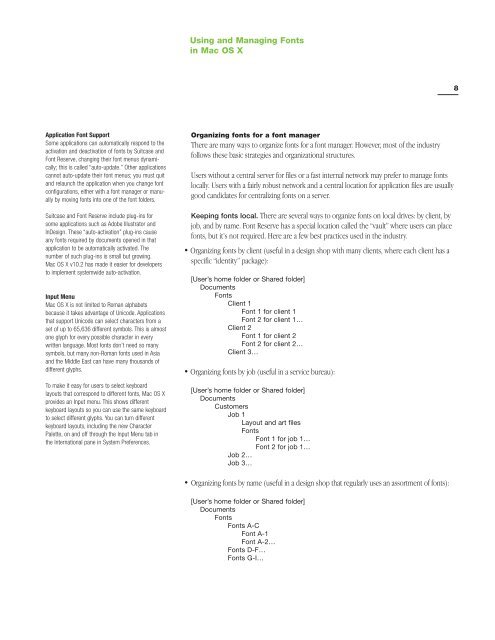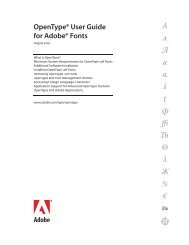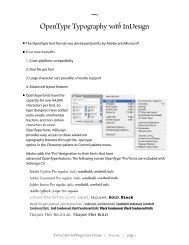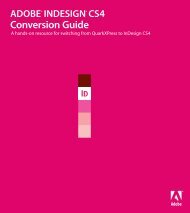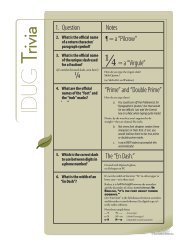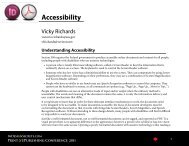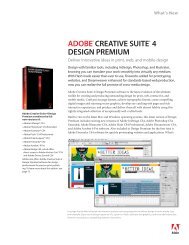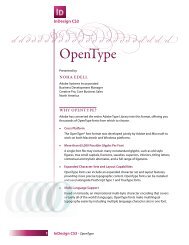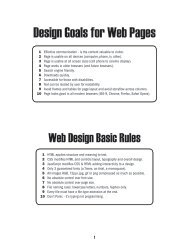Using and Managing Fonts in Mac OS X - UC Davis Department of ...
Using and Managing Fonts in Mac OS X - UC Davis Department of ...
Using and Managing Fonts in Mac OS X - UC Davis Department of ...
You also want an ePaper? Increase the reach of your titles
YUMPU automatically turns print PDFs into web optimized ePapers that Google loves.
<strong>Us<strong>in</strong>g</strong> <strong>and</strong> <strong>Manag<strong>in</strong>g</strong> <strong>Fonts</strong><br />
<strong>in</strong> <strong>Mac</strong> <strong>OS</strong> X<br />
8<br />
Application Font Support<br />
Some applications can automatically respond to the<br />
activation <strong>and</strong> deactivation <strong>of</strong> fonts by Suitcase <strong>and</strong><br />
Font Reserve, chang<strong>in</strong>g their font menus dynamically;<br />
this is called “auto-update.” Other applications<br />
cannot auto-update their font menus; you must quit<br />
<strong>and</strong> relaunch the application when you change font<br />
configurations, either with a font manager or manually<br />
by mov<strong>in</strong>g fonts <strong>in</strong>to one <strong>of</strong> the font folders.<br />
Suitcase <strong>and</strong> Font Reserve <strong>in</strong>clude plug-<strong>in</strong>s for<br />
some applications such as Adobe Illustrator <strong>and</strong><br />
InDesign. These “auto-activation” plug-<strong>in</strong>s cause<br />
any fonts required by documents opened <strong>in</strong> that<br />
application to be automatically activated. The<br />
number <strong>of</strong> such plug-<strong>in</strong>s is small but grow<strong>in</strong>g.<br />
<strong>Mac</strong> <strong>OS</strong> X v10.2 has made it easier for developers<br />
to implement systemwide auto-activation.<br />
Input Menu<br />
<strong>Mac</strong> <strong>OS</strong> X is not limited to Roman alphabets<br />
because it takes advantage <strong>of</strong> Unicode. Applications<br />
that support Unicode can select characters from a<br />
set <strong>of</strong> up to 65,636 different symbols. This is almost<br />
one glyph for every possible character <strong>in</strong> every<br />
written language. Most fonts don’t need so many<br />
symbols, but many non-Roman fonts used <strong>in</strong> Asia<br />
<strong>and</strong> the Middle East can have many thous<strong>and</strong>s <strong>of</strong><br />
different glyphs.<br />
To make it easy for users to select keyboard<br />
layouts that correspond to different fonts, <strong>Mac</strong> <strong>OS</strong> X<br />
provides an Input menu. This shows different<br />
keyboard layouts so you can use the same keyboard<br />
to select different glyphs. You can turn different<br />
keyboard layouts, <strong>in</strong>clud<strong>in</strong>g the new Character<br />
Palette, on <strong>and</strong> <strong>of</strong>f through the Input Menu tab <strong>in</strong><br />
the International pane <strong>in</strong> System Preferences.<br />
Organiz<strong>in</strong>g fonts for a font manager<br />
There are many ways to organize fonts for a font manager. However, most <strong>of</strong> the <strong>in</strong>dustry<br />
follows these basic strategies <strong>and</strong> organizational structures.<br />
Users without a central server for files or a fast <strong>in</strong>ternal network may prefer to manage fonts<br />
locally. Users with a fairly robust network <strong>and</strong> a central location for application files are usually<br />
good c<strong>and</strong>idates for centraliz<strong>in</strong>g fonts on a server.<br />
Keep<strong>in</strong>g fonts local. There are several ways to organize fonts on local drives: by client, by<br />
job, <strong>and</strong> by name. Font Reserve has a special location called the “vault” where users can place<br />
fonts, but it’s not required. Here are a few best practices used <strong>in</strong> the <strong>in</strong>dustry.<br />
• Organiz<strong>in</strong>g fonts by client (useful <strong>in</strong> a design shop with many clients, where each client has a<br />
specific “identity” package):<br />
[User’s home folder or Shared folder]<br />
Documents<br />
<strong>Fonts</strong><br />
Client 1<br />
Font 1 for client 1<br />
Font 2 for client 1…<br />
Client 2<br />
Font 1 for client 2<br />
Font 2 for client 2…<br />
Client 3…<br />
• Organiz<strong>in</strong>g fonts by job (useful <strong>in</strong> a service bureau):<br />
[User’s home folder or Shared folder]<br />
Documents<br />
Customers<br />
Job 1<br />
Layout <strong>and</strong> art files<br />
<strong>Fonts</strong><br />
Font 1 for job 1…<br />
Font 2 for job 1…<br />
Job 2…<br />
Job 3…<br />
•Organiz<strong>in</strong>g fonts by name (useful <strong>in</strong> a design shop that regularly uses an assortment <strong>of</strong> fonts):<br />
[User’s home folder or Shared folder]<br />
Documents<br />
<strong>Fonts</strong><br />
<strong>Fonts</strong> A-C<br />
Font A-1<br />
Font A-2…<br />
<strong>Fonts</strong> D-F…<br />
<strong>Fonts</strong> G-I…


